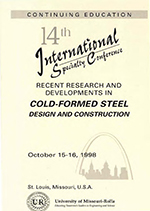Session Dates
15 Oct 1998
Abstract
A series of tests on small lipped channel section columns is reported in this paper. The columns were loaded with varying degrees of eccentricity. The eccentricity of loading was produced by offsetting the loading line from the neutral axis of the section, and the offset could be set to a different degree at each end of the column. By this means the effect of moment variation along the column could be examined experimentally and the results compared with the predictions of different design codes for this type of loading. The predictions of the 1986 AISI Specification, the British Standard and the Eurocode were compared with the experimental results, and all of these would appear to be quite accurate on the whole in relation to the experimental results.
Department(s)
Civil, Architectural and Environmental Engineering
Research Center/Lab(s)
Wei-Wen Yu Center for Cold-Formed Steel Structures
Meeting Name
14th International Specialty Conference on Cold-Formed Steel Structures
Publisher
University of Missouri--Rolla
Document Version
Final Version
Rights
© 1998 University of Missouri--Rolla, All rights reserved.
Document Type
Article - Conference proceedings
File Type
text
Language
English
Recommended Citation
Rhodes, J., "Columns under Loads of Varying Eccentricity" (1998). CCFSS Proceedings of International Specialty Conference on Cold-Formed Steel Structures (1971 - 2018). 2.
https://scholarsmine.mst.edu/isccss/14iccfsss/14iccfsss-session4/2
Columns under Loads of Varying Eccentricity
A series of tests on small lipped channel section columns is reported in this paper. The columns were loaded with varying degrees of eccentricity. The eccentricity of loading was produced by offsetting the loading line from the neutral axis of the section, and the offset could be set to a different degree at each end of the column. By this means the effect of moment variation along the column could be examined experimentally and the results compared with the predictions of different design codes for this type of loading. The predictions of the 1986 AISI Specification, the British Standard and the Eurocode were compared with the experimental results, and all of these would appear to be quite accurate on the whole in relation to the experimental results.



